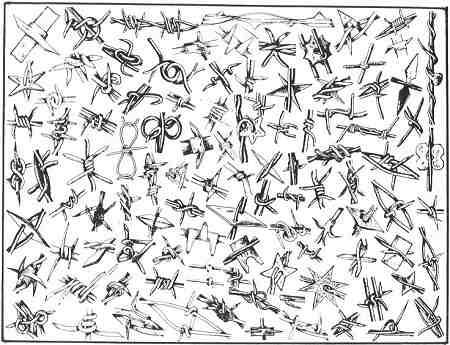A BRIEF HISTORY of BARBED WIRE
BEFORE BARBED WIRE
Since the beginning of time, man has constructed his barriers from natural materials adjacent to the barrier site. These materials were mostly wood from trees, stone, thorny brush, and mud. When settlers arrived on the Great Plains of America, they found these materials in short supply, thus creating a demand for a more economical type of fencing.SMOOTH WIRE DEVELOPMENT
Dating back to 400 A.D., the process of pulling hot, bloom iron through dies in a drawing plate produced short lengths of various sizes of smooth wire. By 1870, good quality smooth wire was readily available in all sizes and lengths. Stockmen used the smooth wire in fencing but found it was not a dependable deterrent to livestock passage.THE INVENTION OF WIRE WITH POINTS
In 1867, two inventors tried adding points to the smooth wire in an effort to make a more effective deterrent. One example was not practical to manufacture, the other experienced financial problems. In 1868, Michael Kelly invented a practical wire with points which was used in quantity until 1874.THE INVENTION OF BARBED WIRE
Joseph F. Glidden of Dekalb, Illinois attended a county fair where he observed a demonstration of a wooden rail with sharp nails protruding along its sides, hanging inside a smooth wire fence. This inspired him to invent and patent a successful barbed wire in the form we recognize today. Glidden fashioned barbs on an improvised coffee bean grinder, placed them at intervals along a smooth wire, and twisted another wire around the first to hold the barbs in a fixed position.THE BARBED WIRE BOOM
The advent of Glidden's successful invention set off a creative frenzy that eventually produced over 570 barbed wire patents. It also set the stage for a three-year legal battle over the rights to these patents.THE FATHER OF BARBED WIRE
When the legal battles were over, Joseph Glidden was declared the winner and the Father of Barbed Wire. The aftermath forced many companies to merge facilities or sell their patent rights to the large wire and steel companies.ACCEPTING THE DEVIL'S ROPE
When livestock encountered barbed wire for the first time, it was usually a painful experience. The injuries provided sufficient reason for the public to protest its use. Religious groups called it "the work of the devil," or "The Devil's Rope" and demanded removal.
Free range grazers became alarmed the economical new barrier would mean the end of their livelihood. Trail Drivers were concerned their herds would be blocked from the Kansas markets by settler fences. Barbed wire fence development stalled.THE FENCE CUTTER WARS
With landowners building fences to protect crops and livestock, and those opposed fighting to keep their independence, violence occurred requiring laws to be passed making wire cutting a felony. After many deaths, and uncountable financial losses, the Fence Cutter Wars ended.NEED AND PROMOTION TRIUMPH OVER OPPOSITION
A demonstration in the Military Plaza in San Antonio by John "Bet a Million" Gates, proved beyond a doubt barbed wire was durable and successful in controlling livestock. With his expertise in salesmanship, he eventually became the largest stockholder in American Steel & Wire Company and a legend in barbed wire history.THE LAST STRAW
The last opposition fell when the large ranches in Texas began fencing their boundaries and cross fencing within. Among the first to fence were The Frying Pan Ranch, The XIT, and the JA Ranch, all located in the Texas Panhandle.PRESERVATION OF, AND COLLECTING BARBED WIRE
There are over 530 patented barbed wires, approximately 2,000 variations and over 2,000 patented barbed wire tools to collect as well as advertising, salesmen samples, wire cut medicine bottles, and other wire related items.
